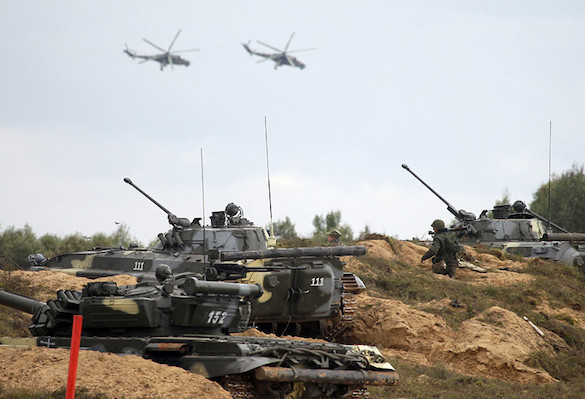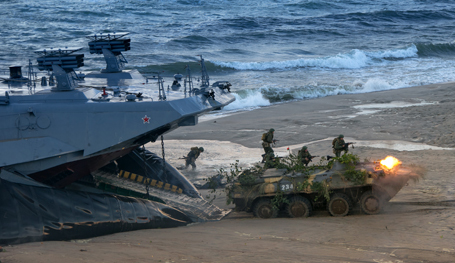Western strategists hire 'Mother Goose' to tell stories about Russia Zapad 2017 drills
Zapad 2017 military drills caused an unprecedented surge of interest in the West. Predictably, Western publications used the joint Russia-Belarus drills to instil fear in readers. The goal of the propaganda campaign is to unite people against the Russian threat and call down several "not very obedient" NATO members. Yet, the latter want to share NATO's money, but they do not want to die for the mythical unity of the alliance.

Humpty-Dumpty sat on a wall...
Lieutenant General Ben Hodges, commander of the US Army in Europe, described Zapad 2017 exercises as a "Trojan horse" that may invade Eastern Europe. Experts from the US Defence Intelligence Agency concluded that the exercises are held as preparations for an invasion of Germany and a nuclear attack on Europe. US-based website Defence News reminded that Russia's "invasions" of Georgia in 2008 and of Ukraine in 2014 also started from military manoeuvres.
Eastern Europe nodded to the Americans in the face of Polish Defence Minister Antoni Macierewicz and Lithuanian President Grybauskaite, who proclaimed Zapad 2017 exercises to be "a threat" to their countries. French Defence Minister Florence Parley called the exercises a part of Moscow's "strategy of intimidation." Her compatriot, a host of France 24 television channel, said in a evening news programme that Russia released its 100,000-strong "hordes" to carry out the manoeuvres on the borders of the European Union, which can be more accurately referred to as an "attacks." It should be noted here that the drills take place with the participation of up to 13,000 servicemen and NATO observers.
French geopolitician Jean-Sylvestre Mongrenier wrote for Atlantico.fr that Russia holds the military manoeuvres to put psychological pressure on the West in order to weaken the ties between Europe and NATO as well as between different parts of Europe. The expert believes that Russia successfully complements this military strategy with diplomacy to divide the West, by negotiating on a bilateral basis, rather than with blocs.
Zapad 2017 to prevent another Ukraine in Belarus
Practically all Western observers and political scientists tell a terrible fairy tale about the main scenario of the exercises: to train actions to suppress a major revolution in Belarus. The nationalistic project called "Veyshnoria" has been promoted in Western Belarus, Leonid Bershidsky wrote in an article for Bloomberg ("The Zapad military exercise reveals Putin's fear"). According to the author, Belarus is the place where "red lines" of Russia and the West cross. In Belarus, if Lukashenko leaves, a military conflict may occur, Bershidsky assures.
"To the Belarusian dictator, and to the Kremlin, these are symptoms of covert Western influence operations, the kind that led to the Ukrainian revolution. Only if the same happens in Belarus, Russia intends to interfere more forcefully. And if it does, it expects a military response from the U.S., given Belarus's proximity to the Baltic states, which the U.S. has vowed to defend," the article reads.
The author then quotes Michael Kofman, an expert on the Russian military and fellow at the Kennan Institute: "Belarus is 100 percent the most likely cause of a fight between Russia and the U.S. [...] Belarus on the other hand can fall victim to all sorts of crises and the Russian fear is that neighboring countries will play games that ultimately result in war."
We would like to note here that Mr. Kofman is not familiar with the Russian military doctrine. It states that the Russian Federation reserves the right to use nuclear weapons in response to the use of nuclear and other types of weapons of mass destruction against the russian Federation and (or) its allies, as well as in case of aggression against the Russian Federation with the use of conventional weapons, when the existence of the state is threatened.
"The scenario of a revolution in Belarus, as it was in Ukraine, is unlikely," Colonel-General Leonid Ivashov, president of the Academy of Geopolitical Problems, told Pravda.Ru. "This is a hoax. The media who propagate the story were paid for it. We should not buy into this," he added.
As for the "Trojan horse" that Russia used in 2008 to "invade" Georgia: it was not Russia that attacked Georgia. It was Georgia that invaded Ossetia, and Russia responded without any preliminary exercises.
In fact, the media hype around Zapad 2017 drills is an attempt to reanimate solidarity within NATO in the face of the "Russian military threat." It is worthy of note that many NATO members have serious problems about their armed forces. One can hear such discussions in France, Britain, the USA, Germany. One of NATO's battle-worthy armies, the army of Turkey, has been making decisive steps towards Russia. Turkey uses NATO's money by taking part in NATO drills and rearming its troops, but the Turks will not go to war to die for interests of the West.
Russia holds Zapad 2017 drills as common, scheduled military exercises for organising defence. The event also comes as a warning to hooligan states that arrange new Libya, new Iraq and new Ukraine every now and then. Russia will not sit on its hands as NATO holds its own drills very close to the territory of the Russian Federation (in Bulgaria, Sweden, Ukraine, Georgia, Romania, in the Black Sea), in which the conventional NATO enemy is always dressed in military uniforms reminiscent of Russian military uniforms. In Romania, Bulgarian soldiers flatly refused to shoot at such targets.
Lyuba Stepushova (Lulko)
Pravda.Ru
Read article on the Russian version of Pravda.Ru
Subscribe to Pravda.Ru Telegram channel, Facebook, RSS!





